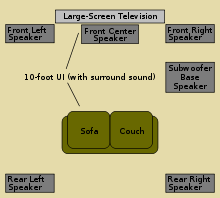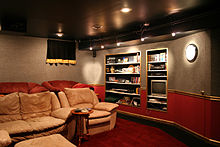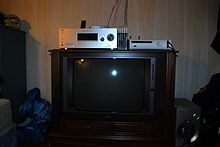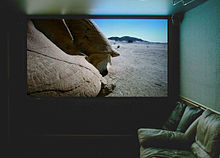- Home cinema
-
 Basic home theater made up of a home entertainment system consisting of large-screen LCD television and a DVD player, (and a Blu-ray Disc capable PlayStation 3 game console).
Basic home theater made up of a home entertainment system consisting of large-screen LCD television and a DVD player, (and a Blu-ray Disc capable PlayStation 3 game console).
Home cinema, also commonly called home theater, are home entertainment set-ups that seek to reproduce a movie theater experience and mood with the help of video and audio equipment in a private home.
In the 1950s, playing home movies became popular in the United States as Kodak 8 mm film projector equipment became affordable. The development of multi-channel audio systems and later LaserDisc in the 1980s created a new paradigm for home video. In the early to mid 1990s, a typical home cinema in the United States would have a LaserDisc or VHS player fed to a large rear-projection television set. Some people were using expensive front projectors in a darkened viewing room. Beginning In the late 1990s, and continuing throughout much of the 2000s home theater technology progressed with the development of the DVD-Video format, Dolby Digital 5.1-channel audio ("surround sound") speaker systems, and high-definition television (HDTV). In the 2010s 3D television technology and Blu-ray Disc have ushered in a new era of home theater once again.
In the 2000s, the term "home cinema" encompasses a range of systems meant for movie playback at home. The most basic and economical system could be a DVD player, a Standard Definition large-screen television with at least a 27" diagonal screen size, and a "home theater in a box" surround sound speaker system with a subwoofer. While a more expensive home cinema set-up might include a Blu-ray Disc player, Home theater PC (HTPC) computer or Digital media receiver streaming devices with a 10-foot user interface, a High Definition video projector and projection screen with a 100+" Diagonal Screen size "and a several thousand-watt home theater receiver with five to seven surround sound speakers plus a powerful subwoofer. The most advanced systems are 3D TV enabled home theaters making use of 3D TV sets/projectors and Blu-ray 3D players which use special glasses to aid viewers in seeing 3D movies and sporting events. Home theater means different things to different people. Home theater designs and layouts are personal choices and the only known minimum set of requirements for a home theater are: A television set or video projector CRT(no new models sold in U.S.), LCD, DLP , Plasma display, organic light-emitting diode (OLED), SXRD, Laser TV, rear-projection TV, video projector, etc. (SDTV, HDTV, or 3DTV) at least 27" inches measured diagonally, an AV receiver or preamp (surround processor) and amplifier combination capable of at least stereo sound but preferably 5.1 Channel Dolby Digital and DTS audio,and something that plays or broadcast movies in at least stereo sound such as a VHS HI-FI VCR or LaserDisc Player (no new stand-alone models of either are available. VHS vcr's are usually bundled in combo decks with DVD players), a DVD player and/or a Blu-ray Disc Player, cable or satellite receiver, video game console, etc. Finally a set of speakers at least two are needed but more common are anywhere from six to eight with a subwoofer for bass or low frequency effects.[1]
The most expensive home theater set-ups, which can cost over $100,000 (US), have expensive digital projectors and projection screens, and maybe even a custom-built screening rooms which include cinema-style chairs and audiophile-grade sound equipment designed to mimic (or sometimes even exceed) commercial theater performance.
Contents
Design
 Common set-up of a basic home cinema layout with standard distance for a 10-foot user interface media player with a big-screen TV and 5.1 surround sound speaker configuration. The distance between viewer and TV varies, but is typically around 10-feet with a 32" or larger big-screen television display.
Common set-up of a basic home cinema layout with standard distance for a 10-foot user interface media player with a big-screen TV and 5.1 surround sound speaker configuration. The distance between viewer and TV varies, but is typically around 10-feet with a 32" or larger big-screen television display.
Today, Home Cinema implies a real "cinema experience" and therefore a higher quality set of components than an average television with only built-in speakers provides. A typical home theater includes the following parts:
- Video and Audio Input Devices: One or more video/audio sources. High quality movie media format such as example Blu-ray Disc are normally preferred, though they often also include a DVD, VHS,Or LaserDisc player and/or video game console systems. Quite a few home theaters today include a HTPC (Home Theater PC) with a media center software application to act as the main library for video and music content using a 10-foot user interface and remote control.
- Audio Processing Devices: Input devices are processed by either a standalone AV receiver or a Preamplifier and Sound Processor for complex surround sound formats such as Dolby Pro-Logic/and or Pro-logic II, X, and Z, Dolby Digital, DTS, Dolby Digital EX, DTS-ES, Dolby Digital Plus, Dolby TrueHD and DTS-HD Master Audio. The user selects the input at this point before it is forwarded to the output.
- Audio Output: Systems consist of at least 2 speakers, however most common today is 5.1 or 7.1 surround sound system, but it is possible to have up to 11 speakers with additional subwoofers.
- Video Output: A large-screen display either an SDTV, HDTV, or 3D TV. Options include Liquid crystal display television (LCD), plasma TV, OLED, SXRD, DLP, Laser TV, rear-projection TV, a traditional CRT TV,(only available second-hand at this point) or video projector and projection screen.
- Atmosphere: Comfortable seating and organization to improve the cinema feel. Higher-end home theaters commonly also have sound insulation to prevent noise from escaping the room, and a specialized wall treatment to balance the sound within the room.
Flow diagram
Component systems vs. theater-in-a-box
Home cinemas can either be set up by purchasing individual components or a HTIB (Home Theater in a Box) which includes all of the pieces from a single manufacturer. The benefit of component purchasing is that one can attain improved quality in video or audio with proper knowledge and research. For instance, some speakers perform better in smaller rooms while others perform better in larger rooms and seating location must be considered. HTIB systems are a simpler and more cost-effective solution for most families.
Dedicated home theater rooms
 This example is of home theater screening room with video projector mounted in a box on the ceiling. Built-in shelves provide a place for movie decor, DVDs, and equipment. Note the component stack on the right, where the audio receiver, DVD player, secondary monitor, and video game system are located.
This example is of home theater screening room with video projector mounted in a box on the ceiling. Built-in shelves provide a place for movie decor, DVDs, and equipment. Note the component stack on the right, where the audio receiver, DVD player, secondary monitor, and video game system are located.
Some home cinema enthusiasts go so far as to build a dedicated room in the home for the theater. These more advanced installations often include sophisticated acoustic design elements, including "room-in-a-room" construction that isolates sound and provides the potential for a nearly ideal listening environment. These installations are often designated as "screening rooms" to differentiate from simpler installations.
This idea can go as far as completely recreating an actual cinema, with a projector enclosed in its own projection room, specialized furniture, curtains in front of the projection screen, movie posters, or a popcorn or vending machine with snack food and confectionery. More commonly, real dedicated home theaters pursue this to a lesser degree. Presently the days of the $100,000 and over home theater is being usurped by the rapid advances in digital audio and video technologies, which has spurred a rapid drop in prices making a home cinema set-up more affordable today than ever before. This in turn has brought the true digital home theater experience to the doorsteps of the do-it-yourself people, often for much less than what you would expect to pay for a low budget economy car. Current consumer level A/V equipment can meet and often exceed in performance what you would expect to experience at a modern commercial theater.
Seating
Home theater seating consists of chairs specifically engineered and designed for viewing movies in a personal home theater setting. Most home theater seats have a cup holder built into the chairs' armrests and a shared armrest between each seat. Some seating is movie theater-style chairs like those seen in a movie cinema, which features a flip-up seat cushion. Other seating systems have plush leather reclining lounger types, with flip-out footrests. Available features include storage compartments, snack trays, tactile transducers for low frequency effects, and electric motors to adjust the chair. Home theater seating tends to be more comfortable than seats in a public cinema.[2]
Backyard theater
In places that have the proper outdoor atmosphere, it is possible for people to set up a home theater in their backyard. Depending on the space available, it may simply be a temporary version with fold able screen, a projector and couple of speakers, or a permanent fixture with huge screens and dedicated audio set up poolside. Due to the outdoor nature, it is quite popular with BBQ parties and pool parties.
Some specialist outdoor home cinema companies are now marketing packages with inflatable movie screens and purpose built AV systems.
Some people have built upon the idea, and constructed mobile drive-in theaters that can play movies in public open spaces. Usually, these require a powerful projector, a laptop or DVD player, outdoor speakers and/or an FM transmitter to broadcast the audio to other car radios.[3][4]
History
1950s, 1960s, and 1970s
In the 1950s, home movies became popular in the United States and elsewhere as Kodak 8 mm film (Pathé 9.5 mm in France) and camera and projector equipment became affordable. Projected with a small, portable movie projector onto a portable screen, often without sound, this system became the first practical home theater. They were generally used to show home movies of family travels and celebrations but also doubled as a means of showing private stag films. Dedicated home cinemas were called screening rooms at the time and were outfitted with 16 mm or even 35 mm projectors for showing commercial films. These were found almost exclusively in the homes of the very wealthy, especially those in the movie industry.
Portable home cinemas improved over time with color film, Kodak Super 8 mm film film cartridges, and monaural sound but remained awkward and somewhat expensive. The rise of home video in the late 1970s almost completely killed the consumer market for 8 mm film cameras and projectors, as VCRs connected to ordinary televisions provided a simpler and more flexible substitute.
1980s
The development of multi-channel audio systems and LaserDisc in the 1980s added new dimensions for home cinema. The first known home cinema system was designed, built and installed by Steve J. LaFontaine as a sales tool at Kirshmans furniture store in Metairie, Louisiana in 1974. He built a special sound room which incorporated the earliest quadraphonic audio systems and he modified Sony Trinitron televisions for projecting the image. Many systems were sold in the New Orleans area in the ensuing years before the first public demonstration of this integration occurred in 1982 at the Summer Consumer Electronics Show in Chicago, Illinois. Peter Tribeman of NAD (USA) organized and presented a demonstration made possible by the collaborative effort of NAD, Proton, ADS, Lucasfilm and Dolby Labs who contributed their technologies to demonstrate what a home cinema would "look and sound" like.
Over the course of three days, retailers, manufacturers, and members of the consumer electronics press were exposed to the first "home like" experience of combining a high quality video source with multi-channel surround sound. That one demonstration is credited with being the impetus for developing what is now a multi-billion dollar business.
1990s
In the early to mid '90s, a typical Home Cinema would have a LaserDisc or VHS player fed to a large screen: rear projection for the more affordable setups, and LCD or CRT front projection in the more elaborate. In the late 1990s, the development of DVD-Video, Dolby Digital and DTS 5.1-channel audio, and high-quality front video projectors that provide a cinema experience at a price that rivals a big-screen HDTV which sparked a new wave of home cinema interest.
2000s
In the 2000s, developments such as high-definition video, Blu-ray Disc (as well as the now-obsolete HD DVD format) and newer high-definition 3D display technologies enabled people to enjoy a cinematic feeling in their own home at an affordable price. Newer lossless audio from Dolby Digital Plus, Dolby TrueHD, DTS-HD High Resolution Audio and DTS-HD Master Audio with more audio channels, like 6.1, 7.1, 9.1, 9.2, 10.2, and 22.2 were also introduced for more cinematic feeling.
Entertainment equipment standards
Noise Criteria (NC) are noise level guidelines applicable to cinema and home cinema. For this application, it is a measure of a room's ambient noise level at various frequencies. For example, in order for a theater to be THX certified, it must have an ambient sound level of NC-30 or less. This helps to retain the dynamic range of the system.[5]
- NC 40: Significant but not a dooming level of ambient noise; the highest "acceptable" ambient noise level. 40 decibels is the lower sound pressure level of normal talking; 60 being the highest.
- NC 30: A good NC level; necessary for THX certification in cinemas.
- NC 20: An excellent NC level; difficult to attain in large rooms and sought after for dedicated home cinema systems. For example, for a home cinema to be THX certified, it has to have a rating of NC 22.[6]
- NC 10: Virtually impossible noise criteria; 10 decibels is associated with the sound level of calm breathing.
Projectors used for home cinemas have a set of recommended criteria.[7]
- Brightness, usually at least 1800 lumens.
- Resolution (the number of pixels making up the image), usually at least 1920 × 1080.
- Contrast (how well white, black and greyscales are displayed), usually a minimum of 5000:1.
- HDMI connection sockets.
- Specific manufacturers, although this is largely a choice of personal preference and budget.
See also
- Media center (disambiguation)
- Home theater PC
- Media server
References
- ^ http://hometheater.about.com/od/hometheaterbasicsfaq/f/htbasicfaq8.htm
- ^ [1] "Create Your Own Home Theater", By Stargate Sonem, Articles Organization Free Directory.
- ^ Guerilla Drive-In
- ^ Mobile Movie
- ^ Wood, Mike (2002). "Design the Ultimate Home Theater--On a Budget." Home Theater.
- ^ DeBoer, Clint (2007)."THX Certified Home Theater Program." Audioholics Online A/V Magazine.
- ^ http://www.grahams.co.uk/home-cinema2/home-cinema-projectors.html
Rooms, spaces, and architectural elements Public areas Airport lounge • Auditorium • Cafeteria • Classroom • Changing room / Locker room • Conference hall • Doctor's office • Function hall • Mailroom • Library • Lobby • Office • Refectory • Restroom • Security • Waiting roomPassages and spaces Alcove • Atrium • Balcony • Breezeway • Corridor • Deck • Elevator • Emergency exit • Escalator • Entryway / Genkan / Mud room • Foyer • Hallway • Loft • Loggia • Nook • Patio • Pedway • Pergola • Porch • porte-cochère • Portico • Ramp • Secret passage • Skyway • Spear closet • Stairway • Terrace • Veranda • Vestibule • Wheelchair rampUtility and storage Attic • Basement • Box room / Carport • Cloakroom • Closet • Electrical room • Equipment room • Furnace room / Boiler room • Garage • Janitorial closet • Laundry room / Utility room • Mechanical room / floor • Pantry • Root cellar • Semi-basement • Studio • Server room • Wardrobe • Workshop • Vault • Wine cellar • Wiring closet / Demarcation pointShared residential rooms Billiard room • Bonus room • Common room • Den • Dining room • Drawing room • Family room • Great room • Hearth room • Home office • Kitchen • Kitchenette • Library • Living room / Lounge / Sitting room • Man cave • Media room or Home theater • Mehmaan khana • Recreation room • Shrines • Study • Sunroom / SolariumPrivate rooms Great house areas Ballroom • Butler's pantry • Buttery • Drawing room • Fainting room • Great chamber • Great hall • Larder • Long gallery • Lumber room • Parlour • Root cellar • Salon • Saucery • Scullery • Servants' hall • Servants' quarters • Smoking room • Solar • Spicery • Stillroom • UndercroftOther areas Barn • Boathouse • Conservatory • Gym • Loading dock • Moon gate • Outhouse • Secondary suite • Shed • Stable • Storm cellar or Storm roomArchitectural elements Related terms Categories:
Wikimedia Foundation. 2010.



